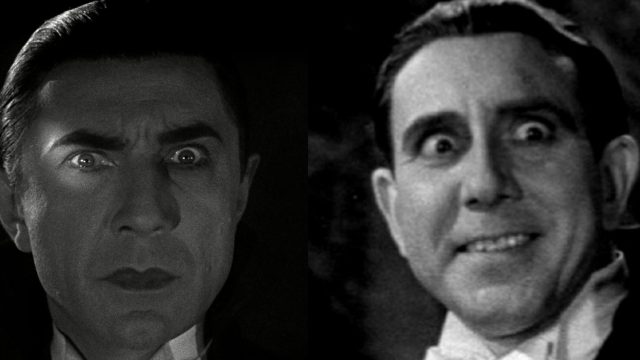There comes a time in every horror fan’s life when they have to pick a side. Are you a Dracula fan? Or a Drácula fan? It’s a confusing argument to have in writing, perhaps even more so in person, but both sides have merit! The two films in question — shot in shifts on the same set, based on the same script, but with different casts and crews and in different languages — are more different than the back-to-back production might indicate, and make a fascinating case study into how small differences in creative vision and on-screen talent can result in a very different end product.
The two films were each released within a couple of months in early 1931, but sadly, the Spanish version languished in relative obscurity until a partially complete print was discovered and screened in the ’70s. The film’s reputation was boosted further by home video releases and further discoveries and restorations from the ’90s onwards, and once the film was readily available for home consumption and comparison, factions formed — loyal Browning-heads rallied around the established English-language version but the thrill of a fresh take on the Count attracted a growing cult of Melfordites, leading to skirmishes in the streets, divided families and the infamous Dracula Wars of the late 20th Century (or at least that’s how I remember it).
As a latecomer to the Spanish version — the Universal Monsters box set sat not-entirely-finished on my shelf much as Drácula quietly waited for rediscovery in a New Jersey warehouse for more than 30 years — the big surprise was that it’s almost half an hour longer than the English-language Dracula. I expected the variations in framing, camera movements and performance but the huge difference in running time totally caught me off guard. Director George Melford — working on his fourth Spanish-language movie, despite not speaking the language — would apparently watch the footage shot by Tod Browning’s team each day and then work through the night on the alternate version, attempting to borrow the best ideas and improve on them where possible.
In places, it feels like Melford and his Spanish team succeeded. Some of the extended scenes really pack a punch, and going back to Browning’s version afterwards, many stretches suffer in comparison. In particular, Melford’s take on the sea voyage from Drácula’s castle to Whitby uses the extra time to reach a level of savage desolation that is more horrifying than anything the English-language version manages. On the other hand, some scenes feel repetitive and padded, with the film’s lack of a score leading to extended sequences that play out in awkward near-silence. The movie’s closing scene also definitely plays better in the Spanish version. Browning’s version has that familiarly abrupt early-Hollywood “alright, we’re done, go home” vibe, but Melford lingers a little more on the Count’s fate and the surviving characters’ relief to great effect. All in all, the Spanish version’s longer running time probably does give it the edge — but, of course, there are other factors to consider.
Both casts are a mixed bag, with major standouts and drawbacks on each side. Renfield is excellent in both, with each actor really selling the character’s descent into madness — Pablo Alvarez Rubio benefits more than anyone else from his extended screen time in the Spanish version, but Dwight Frye’s take is more unusual, and his hissing weirdness feels like a prototype for Andy Serkis’ Gollum. Helen Chandler effectively plays Mina as a wilting “English rose” type, but Lupita Tovar (who lived to 106! Vampire blood!) is more forceful and glamorous, really commanding the screen. The English-language version suffers a little when it comes to Van Helsing and the comic-relief character Martin, who are both saddled with extremely broad accents of dubious quality. But it’s the title character where the casting really makes a difference, and this is where Browning’s version holds the ace card.
I’ve seen the argument that the Spanish version is better in every way, apart from its lead actor. At a stretch, I agree — but it’s a big stretch. It’s not quite “I like Woody Allen films except for that nervous fella who’s always in ’em” but it still feels like a deal-breaker. Lugosi is Dracula. He’s absolutely magnetic, charming but fearsome, convincingly hypnotic. Carlos Villarías is a drunk uncle at a Halloween party, struggling to choke out the words “I vant to drink your blood!” without laughing through his plastic teeth. When Lugosi bends random characters to his will, it’s totally believable, but when Villarías does it, it borders on laughable. And unfortunately that’s the reason I can’t fully get on board the Drácula train — both movies are flawed gems, but the Spanish version’s main flaw sits right there in the middle of the screen, whereas Browning’s take keeps the shaky stuff flapping around the edges like rubber bats.“I’m Seeing Double! Four Draculas!” – Vomas on Drácula (and Dracula)

